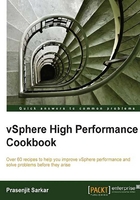
Preface
Welcome to vSphere High Performance Cookbook. In this book, we will teach you how to tune and grow a VMware vSphere 5 Infrastructure. This book will provide you with the knowledge, skills, and abilities to build and run a high-performing VMware vSphere virtual infrastructure. Also, we will look at the detailed, step-by-step coverage, with screenshots that are usually not available in product manuals.
You will learn how to configure and manage ESXi CPU, memory, networking, and storage for sophisticated, enterprise-scale environments. Also, you will learn how to manage changes to the vSphere environment, and optimize the performance of all vSphere components.
This book focuses on high value and often overlooked performance-related topics, such as NUMA Aware CPU Scheduler, VMM Scheduler, Core Sharing, the Virtual Memory Reclamation technique, Checksum offloading, VM DirectPath I/O, queuing on storage array, command queuing, vCenter Server design, and virtual machine and application tuning.
What this book covers
Chapter 1, CPU Performance Design, covers VMM Scheduler, Cache aware CPU Scheduler, Hyperthreaded Core Sharing, Ready Time (%RDY), and so on.
Chapter 2, Memory Performance Design, covers virtual memory reclamation technique, how to rightly size a VM's memory, monitoring host ballooning, swapping activity, and so on.
Chapter 3, Networking Performance Design, covers different vSwitch load balancing, options consideration for checksum offloading, VMDirectPath I/O, NetQueue, SplitRx mode for multicast traffic, Multi NIC vMotion, NIOC, and so on.
Chapter 4, DRS, SDRS, and Resource Control Design, covers the DRS algorithm, resource pool guidelines, SIOC threshold considerations, profile driven storage, SDRS and its affinity/anti-affinity rules, and so on.
Chapter 5, vSphere Cluster Design, covers considerations for scale up and scale out cluster design, FT and its caveats, application monitoring, DPM, Host affinity/anti-affinity rules, and so on.
Chapter 6, Storage Performance Design, covers how to design vSphere storage based on various workloads, how you design iSCSI, FC storage for best performance, considerations for VAAI, and so on.
Chapter 7, Designing vCenter and vCenter Database for Best Performance, covers what platform to choose when designing your vCenter Server, redundant vCenter design, vCenter design for highly-available Auto Deploy, vCenter SSO and its deployment, and so on.
Chapter 8, Virtual Machine and Application Performance Design, covers how to select the best time synchronization in virtual machines, considerations for Virtual NUMA, VM swapfile placement best practices and its impact, and so on.
What you need for this book
You need VMware vSphere 5.1, which includes, VMware vSphere ESXi, vCenter Server, any SSH Client (Putty), and vSphere Client.
Who this book is for
This book is a valuable addition for technical professionals with system administration skills and some VMware experience who wish to learn about advanced optimization and the configuration features and functions of vSphere 5.1.
Conventions
In this book, you will find a number of styles of text that distinguish between different kinds of information.
New terms and important words are shown in bold. Words that you see on the screen, in menus or dialog boxes for example, appear in the text like this: "clicking the Next button moves you to the next screen".
Note
Warnings or important notes appear in a box like this.
Tip
Tips and tricks appear like this.
Reader feedback
Feedback from our readers is always welcome. Let us know what you think about this book—what you liked or may have disliked. Reader feedback is important for us to develop titles that you really get the most out of.
To send us general feedback, simply send an e-mail to <feedback@packtpub.com>, and mention the book title via the subject of your message.
If there is a topic that you have expertise in and you are interested in either writing or contributing to a book, see our author guide on www.packtpub.com/authors.
Customer support
Now that you are the proud owner of a Packt book, we have a number of things to help you to get the most from your purchase.
Errata
Although we have taken every care to ensure the accuracy of our content, mistakes do happen. If you find a mistake in one of our books—maybe a mistake in the text or the code—we would be grateful if you would report this to us. By doing so, you can save other readers from frustration and help us improve subsequent versions of this book. If you find any errata, please report them by visiting http://www.packtpub.com/submit-errata, selecting your book, clicking on the errata submission form link, and entering the details of your errata. Once your errata are verified, your submission will be accepted and the errata will be uploaded on our website, or added to any list of existing errata, under the Errata section of that title. Any existing errata can be viewed by selecting your title from http://www.packtpub.com/support.
Piracy
Piracy of copyright material on the Internet is an ongoing problem across all media. At Packt, we take the protection of our copyright and licenses very seriously. If you come across any illegal copies of our works, in any form, on the Internet, please provide us with the location address or website name immediately so that we can pursue a remedy.
Please contact us at <copyright@packtpub.com> with a link to the suspected pirated material.
We appreciate your help in protecting our authors, and our ability to bring you valuable content.
Questions
You can contact us at <questions@packtpub.com> if you are having a problem with any aspect of the book, and we will do our best to address it.